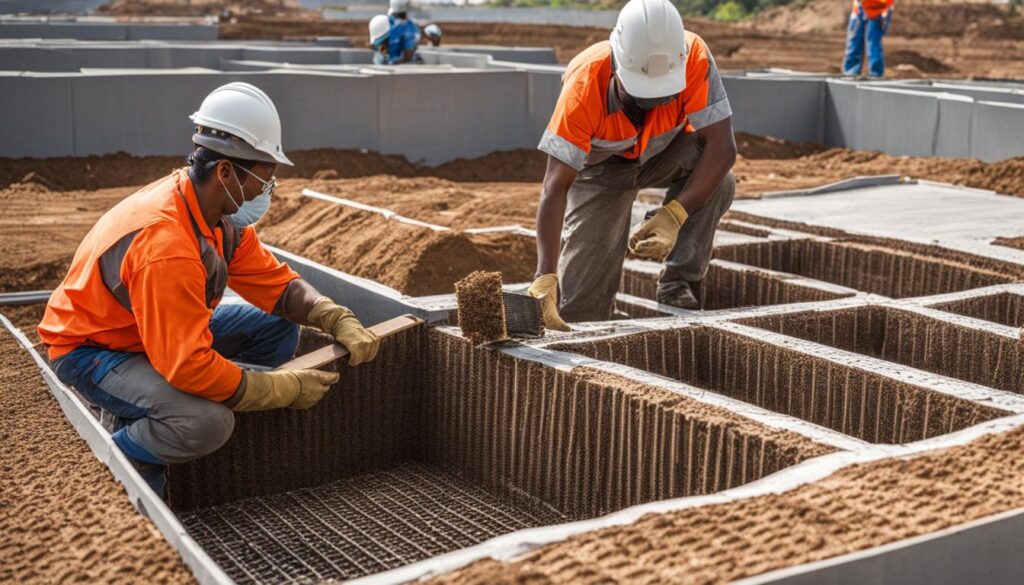A honeycomb foundation is a crucial component in building robust and efficient structures. It provides a strong base for construction, utilizing a honeycomb core structure. The honeycomb construction technique offers lightweight and eco-friendly foundations that are both strong and resilient. This guide will explore the various aspects of honeycomb foundations to help you make informed decisions for your construction projects.
Key Takeaways
- Honeycomb foundations offer a strong and durable base for construction projects.
- The honeycomb core provides exceptional strength while reducing the weight of the foundation.
- Honeycomb foundations are eco-friendly, utilizing sustainable materials.
- They have a wide range of applications in industries such as aerospace, automotive, and marine.
- Choosing the right honeycomb foundation involves considering factors like load-bearing capacity and environmental conditions.
Understanding the Basics of Honeycomb Foundations
When it comes to building a strong and durable foundation, honeycomb foundations are gaining popularity in the construction industry. These foundations are constructed using honeycomb panels, which are lightweight yet incredibly strong. The honeycomb core structure provides exceptional strength while reducing the weight of the foundation, making it an ideal choice for various applications.
Honeycomb foundations are not only known for their strength but also for their eco-friendly nature. They are made from sustainable materials, making them a sustainable option for environmentally conscious projects. By understanding the basics of honeycomb foundations, you can make informed decisions and create a strong and long-lasting base for your construction projects.
Honeycomb foundations offer a lightweight alternative to traditional foundations without compromising on strength. The honeycomb panels are designed to distribute loads evenly, resulting in a strong and stable foundation. These foundations are commonly used in industries such as aerospace and automotive, where both strength and weight reduction are crucial factors.
Furthermore, the eco-friendly nature of honeycomb foundations makes them even more appealing. By using sustainable materials, these foundations help reduce the carbon footprint of buildings and structures. With their exceptional strength, lightweight construction, and eco-friendly attributes, honeycomb foundations are a promising solution for creating strong and sustainable structures.
Benefits of Honeycomb Foundations:
- Exceptional strength and durability
- Lightweight construction
- Eco-friendly and sustainable
- Reduces the carbon footprint
- Wide range of applications in various industries
By understanding the basics of honeycomb foundations and their benefits, you can make informed decisions when it comes to selecting a strong and eco-friendly foundation for your construction projects.
Benefits of Using Honeycomb Foundations
Honeycomb foundations offer several benefits that make them a preferred choice in construction. Their lightweight nature reduces the overall weight of the structure while maintaining exceptional strength. This makes them ideal for applications where weight is a concern, such as aerospace or automotive industries.
Additionally, honeycomb foundations are eco-friendly, as they use sustainable materials and reduce the carbon footprint of a building or structure. The honeycomb core structure allows for efficient use of materials, minimizing waste and promoting sustainability.
Moreover, honeycomb foundations provide excellent thermal insulation properties, making them energy-efficient and cost-effective. The honeycomb structure traps air inside the cells, creating a barrier against heat transfer. This can result in reduced heating and cooling costs and a more comfortable living or working environment.
Benefits of Using Honeycomb Foundations:
- Lightweight construction reduces overall weight of the structure
- Eco-friendly materials and sustainable construction
- Efficient use of materials minimizes waste
- Excellent thermal insulation properties for energy-efficiency
By utilizing honeycomb foundations, builders and architects can create structures that are both strong and environmentally friendly. These foundations offer a range of benefits, from reducing weight and improving energy efficiency to promoting sustainability. With their lightweight construction and exceptional strength, honeycomb foundations are a reliable option for various industries and applications.
Quote:
“The lightweight and eco-friendly nature of honeycomb foundations, combined with their exceptional strength, make them a game-changer in the construction industry.” – [Expert Name], Construction Engineer
With the increasing emphasis on sustainable and efficient construction practices, honeycomb foundations are becoming more prevalent in modern building projects. Their benefits extend beyond just the initial construction phase, as they contribute to a greener and more cost-effective building lifecycle. By adopting honeycomb foundations, builders can create structures that are not only strong and durable but also environmentally conscious.
Next, we will explore the various applications of honeycomb foundations, showcasing their versatility and wide range of uses in industries such as aerospace, automotive, and marine. From aircraft construction to structural panels, honeycomb foundations continue to revolutionize the way we build and design structures.
Applications of Honeycomb Foundations
Honeycomb foundations have a wide range of applications in various industries, thanks to their exceptional strength and lightweight nature. The honeycomb construction technique is utilized in the production of structural honeycombs and prestressed honeycomb panels, offering versatility and resilience for different sectors.
Honeycomb Foundations in Aerospace Industry
In the aerospace industry, honeycomb foundations are commonly used in the construction of aircraft. The lightweight nature of honeycomb structures allows for reduced fuel consumption and increased payload capacity, making them ideal for aircraft manufacturers. The honeycomb cores provide excellent stiffness and durability, ensuring the structural integrity of the aircraft while minimizing weight.
Honeycomb Foundations in Automotive Industry
The automotive industry also benefits from the use of honeycomb foundations. The lightweight and strong properties of honeycomb structures enable car manufacturers to improve fuel efficiency and enhance vehicle performance. Honeycomb foundations can be found in various parts of automobiles, such as door panels, hoods, and chassis components.
Structural Honeycomb Applications
Structural honeycombs are used in a wide range of applications, including building construction, furniture manufacturing, and interior design. The strength and stability of structural honeycomb foundations make them suitable for load-bearing structures, providing a reliable and durable base for buildings and other architectural elements. Additionally, structural honeycombs can be used for decorative purposes, creating visually appealing and unique designs.
| Application | Industry |
|---|---|
| Aircraft construction | Aerospace |
| Automobile components | Automotive |
| Building construction | Construction |
| Furniture manufacturing | Interior Design |
Choosing the Right Honeycomb Foundation for Your Project
When it comes to selecting a honeycomb foundation for your construction project, there are several factors to consider to ensure the best possible outcome. By carefully evaluating the options available and understanding the specific requirements of your project, you can choose a honeycomb foundation that provides the ideal balance of strength, durability, and performance.
One of the key considerations is the honeycomb core. Different materials and designs offer varying levels of strength and load-bearing capacity. It’s essential to assess the intended application and the expected weight and stress the foundation will need to support. Additionally, consider any environmental conditions that may impact the performance of the foundation, such as temperature fluctuations or exposure to moisture.
Another crucial factor is the honeycomb panel itself. Look for panels that are lightweight yet robust, as they need to provide a stable base for your construction project. Consider the durability and longevity of the panels, as well as their insulation properties. Depending on your project’s requirements, you may need panels with enhanced thermal insulation or fire-resistant properties.
Additionally, it’s essential to evaluate the overall compatibility of the honeycomb foundation with your project’s design and engineering requirements. Consult with experts who specialize in honeycomb construction to ensure that the foundation aligns with your project’s specifications and goals. By choosing the right honeycomb foundation, you can lay the groundwork for a successful and efficient construction project.
Key Considerations for Choosing a Honeycomb Foundation:
- Evaluate the strength and load-bearing capacity of the honeycomb core
- Assess the durability, longevity, and insulation properties of the honeycomb panels
- Consider the compatibility with your project’s design and engineering requirements
- Consult with honeycomb construction experts for professional advice
| Honeycomb Foundation | Honeycomb Core | Honeycomb Panel |
|---|---|---|
| Provides a strong and seamless base for construction projects | Offers exceptional strength and load-bearing capacity | Lightweight yet robust panels for stability and insulation |
| Eco-friendly and sustainable choice for construction | Choose materials and designs based on intended application | Durable and long-lasting panels for optimal performance |
| Wide range of applications in various industries | Consider environmental conditions and stress factors | Insulation properties for energy efficiency |
Installation and Maintenance of Honeycomb Foundations
Proper installation and maintenance are essential for the longevity and performance of honeycomb foundations. Following manufacturer guidelines for installation is crucial to ensure a secure and stable foundation. Additionally, regular maintenance, including inspections and repairs, helps identify and address any issues promptly.
During the installation process, it is important to carefully handle the honeycomb panels to avoid any damage to the structure. Adhering to the recommended installation techniques, such as using appropriate adhesives and fasteners, ensures the panels are securely attached to each other and to the surrounding structure.
Once the honeycomb foundation is in place, regular inspections are necessary to monitor its condition. These inspections should include checking for any signs of wear and tear, such as cracks or delamination, and addressing them promptly to prevent further damage. Additionally, it is important to inspect the surrounding area for any potential risks that may affect the stability of the foundation, such as soil erosion or water seepage.
Table: Honeycomb Foundation Maintenance Checklist
| Task | Frequency |
|---|---|
| Visual inspection for cracks, delamination, or damage | Every 6 months |
| Check for signs of soil erosion or water seepage | Every 6 months |
| Inspect surrounding structure for any changes that may affect foundation stability | Every 6 months |
| Address repairs or maintenance as needed | As soon as issues are identified |
| Ensure proper drainage systems are in place | Regularly check and maintain |
Regular inspections and prompt repairs are crucial to maintaining the integrity of honeycomb foundations. By following the recommended maintenance practices, you can maximize the lifespan and efficiency of your foundation, ensuring its long-term performance. Remember, a well-maintained honeycomb foundation provides a strong and seamless base for your construction project.
By prioritizing proper installation and regular maintenance, you can ensure the optimal performance and longevity of your honeycomb foundation. Proactive measures such as visual inspections, addressing repairs promptly, and monitoring the surrounding area contribute to the overall stability and durability of the foundation. Follow the manufacturer’s guidelines and consult with experts when needed to ensure the best practices are implemented throughout the installation and maintenance processes.
Alt text: An image showing the installation of a honeycomb foundation with workers carefully handling the honeycomb panels.

Honeycomb Foundations vs. Traditional Foundations
When it comes to building a strong and durable foundation, two options often come to mind: honeycomb foundations and traditional foundations. Each has its own set of advantages and considerations that need to be taken into account. Let’s compare these two types of foundations to help you make an informed decision for your construction project.
Strength and Weight
One of the key differences between honeycomb foundations and traditional foundations lies in their strength and weight. Honeycomb foundations, with their unique honeycomb core structure, offer exceptional strength while significantly reducing the weight of the foundation. This lightweight characteristic not only makes honeycomb foundations easier to handle and install but also reduces the overall load on the structure, potentially leading to cost savings in materials and transportation.
On the other hand, traditional foundations rely on solid materials such as concrete or stone, which provide tremendous strength but contribute to the overall weight of the foundation. While these materials are tried and tested, they can be more cumbersome to work with and may require more extensive excavation and construction efforts.
Environmental Impact
In today’s world, sustainability and eco-friendliness are crucial considerations in construction. Honeycomb foundations shine in this aspect, as they are made from eco-friendly materials and contribute to a reduced carbon footprint. The use of sustainable materials and the lightweight nature of honeycomb foundations align with the principles of green building practices, making them an environmentally conscious choice.
Traditional foundations, on the other hand, may involve the use of more resource-intensive materials and construction methods. The extraction and processing of these materials can have a significant environmental impact, especially when sourced from non-renewable sources.
Choosing the Right Foundation
When deciding between honeycomb foundations and traditional foundations, it’s essential to consider the specific requirements of your project. Factors such as the intended application, load-bearing capacity, and environmental conditions should all be taken into account. Evaluating the strength, weight, and sustainability aspects of each foundation type will help you determine the best fit for your construction project.
Ultimately, both honeycomb foundations and traditional foundations have their advantages and considerations. By thoroughly assessing the unique needs of your project and considering the factors outlined above, you can make an informed decision that leads to a strong and resilient foundation.
| Comparison | Honeycomb Foundations | Traditional Foundations |
|---|---|---|
| Strength | Exceptional strength with a lightweight structure | Tremendous strength but heavier due to solid materials |
| Weight | Significantly lighter, reducing overall load on the structure | Heavier due to the use of solid materials |
| Environmental Impact | Made from eco-friendly materials, reducing the carbon footprint | May involve resource-intensive materials and processes |
| Considerations | Requires careful evaluation of load-bearing capacity and environmental conditions | May involve more extensive excavation and construction efforts |
As you can see, honeycomb foundations offer unique advantages in terms of strength and weight, as well as environmental sustainability. However, traditional foundations have their own strengths based on their solid materials. By carefully considering your project’s requirements and weighing the pros and cons of each foundation type, you can make an informed decision that aligns with your construction goals.
Challenges and Considerations of Honeycomb Foundations
While honeycomb foundations offer numerous benefits, there are several challenges and considerations that need to be taken into account during the planning and implementation stages. These factors can impact the cost, availability of materials, and overall success of the honeycomb foundation.
Cost
One of the primary challenges of honeycomb foundations is the cost associated with their production and installation. The specialized materials and manufacturing processes involved in creating honeycomb structures can be more expensive than traditional foundation methods. Additionally, the expertise required for designing and engineering honeycomb foundations may also contribute to higher costs. It is crucial to carefully evaluate the budget and cost-effectiveness of using honeycomb foundations before proceeding with the project.
Material Availability
Another consideration is the availability of honeycomb materials. While honeycomb foundations have gained popularity in recent years, the supply chain for these specialized materials may not be as established or readily accessible as traditional construction materials. This can impact project timelines and add complexity to the procurement process. It is important to work with suppliers who have a reliable track record and can ensure a consistent supply of high-quality honeycomb materials.
Specialized Installation
Honeycomb foundations often require specialized installation techniques and equipment. The precise alignment and assembly of honeycomb panels are crucial for ensuring the structural integrity of the foundation. This may involve the use of specialized tools and machinery, as well as skilled labor. It is essential to engage experienced contractors or construction teams familiar with honeycomb foundation installation to avoid costly mistakes or structural issues.

By addressing these challenges and considering the necessary factors, such as cost, material availability, and specialized installation requirements, you can overcome potential obstacles and achieve a successful honeycomb foundation for your construction project. It is vital to conduct thorough research and work with knowledgeable professionals to ensure the best outcomes.
Future Trends in Honeycomb Foundation Technology
The field of honeycomb foundation technology is constantly evolving, driven by advancements in materials and manufacturing techniques. Researchers and engineers are dedicated to improving the strength, durability, and sustainability of honeycomb foundations, making them even more efficient and cost-effective for construction projects. Let’s explore some of the exciting future trends in honeycomb foundation technology.
1. Advanced Materials
One of the key areas of development in honeycomb foundation technology is the exploration of advanced materials. Researchers are experimenting with composite materials that offer enhanced strength and performance. These materials, such as carbon fiber reinforced polymers (CFRPs) and graphene-based composites, have the potential to revolutionize the construction industry by providing honeycomb foundations with superior strength-to-weight ratios and increased resistance to external factors like corrosion and impact. The incorporation of these advanced materials can result in more durable and resilient honeycomb foundations.
2. Smart Honeycomb Foundations
The rise of smart technologies is also influencing the future of honeycomb foundation technology. Researchers are exploring the integration of sensors and monitoring systems within honeycomb foundations to enable real-time data collection and analysis. These smart honeycomb foundations can provide valuable insights into the structural health of buildings and infrastructure, allowing for early detection of potential issues and informed maintenance decisions. The use of smart honeycomb foundations can significantly improve the overall safety, performance, and longevity of constructed structures.
3. Sustainable Construction Practices
With an increasing focus on sustainability, future trends in honeycomb foundation technology are centered around eco-friendly construction practices. Researchers are developing bio-based materials for honeycomb foundations, utilizing renewable resources and reducing reliance on non-renewable materials. Additionally, advancements in manufacturing processes aim to minimize waste and energy consumption, further reducing the environmental impact of honeycomb foundation production. By embracing these sustainable practices, the construction industry can contribute to a greener and more sustainable future.
| Trend | Description |
|---|---|
| Advanced Materials | Exploration of composite materials like carbon fiber reinforced polymers (CFRPs) and graphene-based composites to enhance strength and durability. |
| Smart Honeycomb Foundations | Integration of sensors and monitoring systems for real-time data collection and analysis, enabling proactive maintenance and ensuring structural safety. |
| Sustainable Construction Practices | Development of bio-based materials and eco-friendly manufacturing processes to minimize the environmental impact of honeycomb foundation production. |
Through continuous research and innovation, the future of honeycomb foundation technology holds great promise. The use of advanced materials, smart technologies, and sustainable practices will contribute to the construction of stronger, smarter, and more environmentally friendly structures. Stay tuned for these exciting developments in the field of honeycomb foundation technology, as they pave the way for a sustainable and resilient built environment.
Conclusion
In conclusion, honeycomb foundations offer a strong and seamless base for construction projects. Their lightweight nature, coupled with exceptional strength, makes them a popular choice in various industries. By utilizing honeycomb construction techniques, you can create robust and efficient structures that are also environmentally friendly.
The benefits of honeycomb foundations extend beyond their strength and weight. These foundations are made from sustainable materials, reducing the carbon footprint of buildings and structures. Additionally, honeycomb foundations have diverse applications, ranging from aerospace to automotive industries, showcasing their versatility.
When choosing a honeycomb foundation, it is essential to consider factors such as the intended application, load-bearing capacity, and environmental conditions. By making informed choices, you can ensure the success of your project and create a strong and long-lasting base.
As technology continues to advance, the future of honeycomb foundation technology looks promising. Ongoing research aims to improve the strength, durability, and sustainability of these foundations. By staying updated on the latest trends and developments, you can embrace the transformative potential of honeycomb construction for robust and sustainable structures.
FAQ
What is a honeycomb foundation?
A honeycomb foundation is a strong and durable structure made from honeycomb panels with a honeycomb core.
What are the benefits of using honeycomb foundations?
Honeycomb foundations offer a lightweight and eco-friendly alternative, while still maintaining exceptional strength.
Where are honeycomb foundations commonly used?
Honeycomb foundations are widely used in the construction of aircraft, automobiles, and marine vessels.
How do I choose the right honeycomb foundation for my project?
Consider factors such as the intended application, load-bearing capacity, and environmental conditions, as well as the properties of the honeycomb core and panel.
How do I install and maintain a honeycomb foundation?
Follow manufacturer guidelines for installation and conduct regular maintenance, including inspections and repairs.
What are the differences between honeycomb foundations and traditional foundations?
Honeycomb foundations offer a lightweight alternative without compromising strength and provide enhanced insulation properties.
What challenges and considerations should I keep in mind when using honeycomb foundations?
Some potential challenges include cost, availability of materials, specialized installation requirements, and the need for specific expertise in design and engineering.
What future trends can we expect in honeycomb foundation technology?
Ongoing research aims to improve the strength, durability, and sustainability of honeycomb foundations through innovations in materials and manufacturing techniques.




